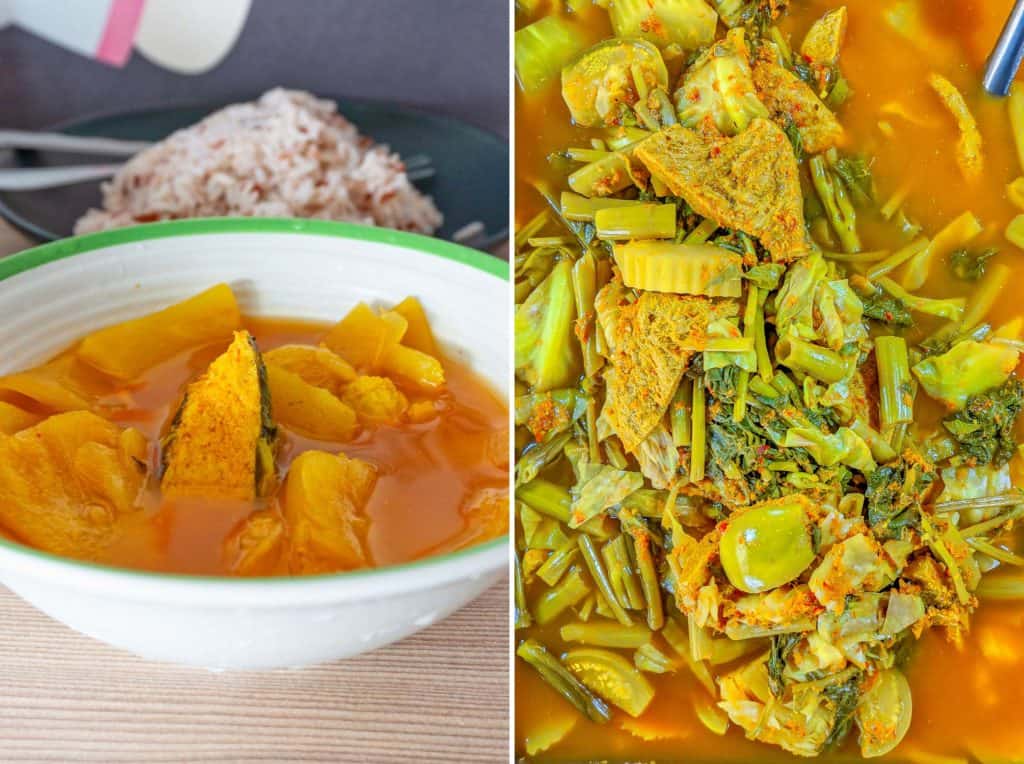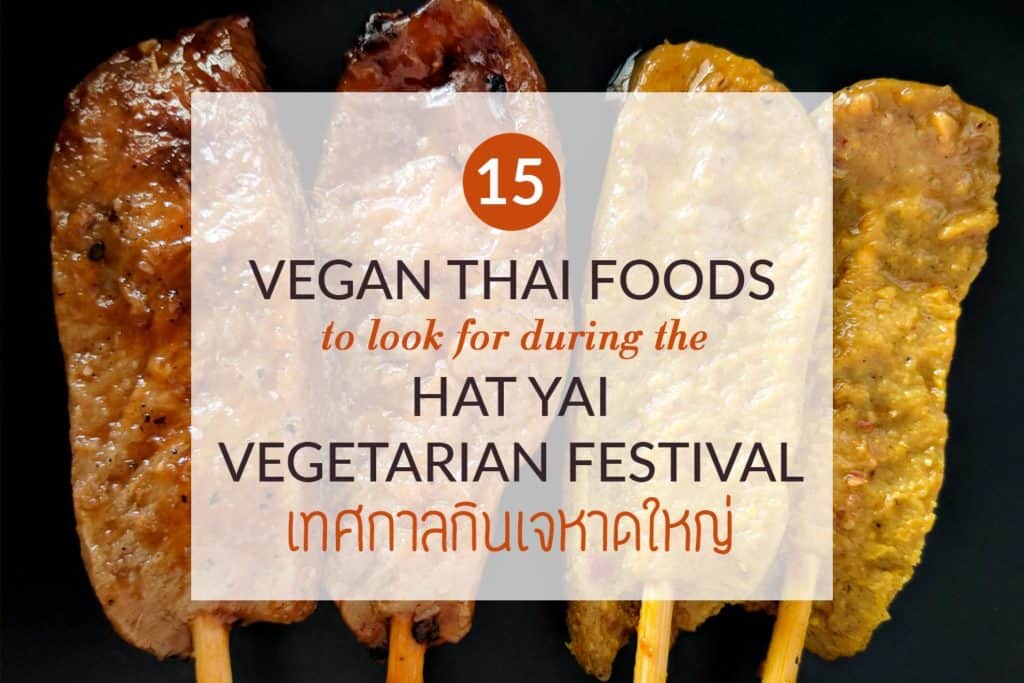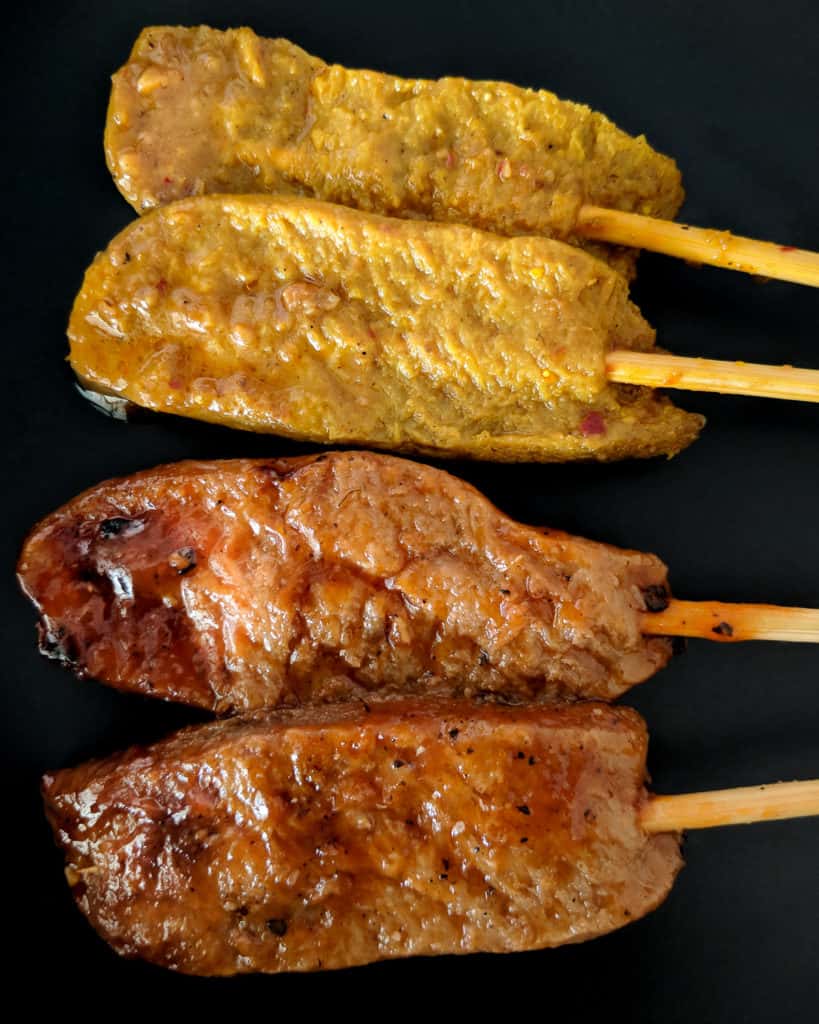The leading narrative of the Thailand vegetarian festival places its origins in Phuket, but the event has spread across the country. Cities and regions with large Chinese-Thai communities celebrate on the grandest scales.
In past years I have divided my time at the festival between Phuket and Bangkok, but in 2018 I opted out of the latter in favour of Hat Yai. This is the largest city in Southern Thailand and the capital of Songkhla Province, which borders Malaysia.
This post is not an exhaustive list of vegan items on offer; that would be impossible to catalogue. Consider the list a photo diary of just some of the foods I tried, enjoyed, and would recommend to others in Hat Yai during the festival.
Locations
The festival in Hat Yai took place largely along Supasarnrangsan Road, with the main festival tent erected near the canal. I also noticed many vendors lining the road on the walk Westbound from the tent toward the train station. Mornings are best spent on this stretch, while the tent is where it all goes down in the evening.
Given the temporary nature of the festival, I can't provide specific locations for most of the foods listed below.
Hat Yai Vegan Food
1. Banana stem curry (gaeng yuuak gluay – แกงหยวกกล้วย)
It's not just banana fruits and leaves that are utilised in Thai kitchens. The stem, called gluay yuuak, is also right tasty in curry. This vegetable isn't limited to the South (gaeng gluay yuak is also a Northern dish), but is a popular vegetable in the region. This curry was made by my friend Nichaphat, who owns a local restaurant and had a stall in the festival tent.

Left to right: Banana stem curry (gaeng yuuak gluay), boat noodles (kuay tiao reua), sour curry noodles (kuay tiao gaeng som)
2. Boat noodles (kuay tiao reua – ก๋วยเตี๋ยวเรือ)
Kuay tiao means rice noodles and reua means boat, hence these are boat noodles. A bowl of kuay tiao reua should represent itself with a deep and complex mingling of flavours, including spices like cinnamon and star anise; aromatics like galangal and lemongrass; and fresh herbs like Thai basil and Chinese celery. This version contained lime (a new to me addition for boat noodles that worked well), vegan pork balls, tofu, spinach, chilli paste, and peanuts. It was the most unusually delightful bowl of boat noodles I have ever enjoyed.
3. Sour curry noodles (kuay tiao gaeng som – ก๋วยเตี๋ยวแกงส้ม)
While we're on the topic of spectacular noodles I'm glad I could read enough Thai to spot the genius stall selling sour curry noodles. A great but unconventional concept (gaeng som curry is typically consumed with rice), this blends Thai noodle soup and curry cultures in one bowl. I have never seen this combination before and nor have any Thai friends I've asked. The soup contained a fish ball, white fungus, char siu style pork, tofu, and Japanese style pickled daikon, among other ingredients.
4. And all the other gaeng som (แกงส้ม)

Two different styles of gaeng som (sour curry). Left is fish and pineapple. Right is water spinach, aubergine, and TVP.
Gaeng som is a water based curry, arguably the easiest of Thai curries to make, and is a staple in the South. Note that central Thai style gaeng som is typically sweeter and is often more reminiscent of sweet and sour soup than of Southern gaeng som. In Bangkok Southern style sour curry is called gaeng luang (แกงเหลือง). Made sour by tamarind (or other local souring agents), this spicy, sour, and salty dish can be made with all sorts of ingredients. I recommend trying several variations. One of my favourites includes vegan fish and pineapple.
5. Pakistani Roti (โรตี)
Infrequently vegan, this roti with condensed milk was a star find. Once a year, during the festival, a major Thai condensed milk brand produces a vegan version that some vendors swap out for their dairy condensed milks. 2019 to do list: learn to make roti. I've already got the condensed milk down. Note: I don't know what makes this roti Pakistani, but that's what the sign says.

Left to right: vegan roti, fermented fish innards curry (gaeng tai plaa), stewed pork leg with pickled mustard greens (khao ka moo)
6. Fermented fish entrails curry (gaeng tai pla – แกงไตปลา)
This Southern curry is made with fermented fish innards called tai pla. Tai pla is similar to pla ra, a fermented fish paste used in Isan (Northeastern Thai) cuisine, and fortunately there are vegan versions. Most of the versions of vegan gaeng tai pla I tried utilised this vegan pla ra. As you might guess, the curry is very funky and its pungency renders it unpopular among many folks who aren't from the South. One of my favourite curries of all time, gaeng tai plaa can be eaten as part of a typical gap khao spread for a family meal and is also great on kanom jeen noodles.
7. Braised pork leg with rice (khao ka moo – ข้าวขาหมู)
This is from Hao Wei, a permanent vegan restaurant in Hat Yai. The proprietor of this restaurant slow simmers large pieces of TVP in a spiced soy broth until they are meltingly tender. Khao ka moo is typically very rich, and so serving it with pickled mustard greens helps to cut through all the delicious fat.
8. Kanom jeen
Kanom jeen are fermented rice noodles, and are the only noodle consumed with curry in Thailand. You can find these noodles anywhere, but the best kanom jeen I've tried is always from the South. There was a stall in the festival tent with a few different pots of curry for kanom jeen. From this stall I tried the gaeng tai pla, gaeng kiao wan (green curry), and nam prik (sweet curry).
9. All the kanom jeen condiments
Kanom jeen is not a fixed dish. Not only are there many curries that pair with these noodles, but with those curries come myriad toppings and accompaniments. Make an effort to try as many of both as possible. In the photo you will see just a small selection. The condiments/toppings served by this vendor included jackfruit in coconut milk, sweet pickles, pickled mustard greens, Thai basil, lemon basil, bean sprouts, cucumber, cha om (acacia leaf), and many local herbs and vegetables (e.g. bai mammuang himaphan, or cashew leaf, and bai man pu).
10. Kuay jap nam kon (ก๋วยจั๊บน้ำข้น)
There are two styles of kuay jap, including nam sai and nam kon. The former is lighter, while the later – the version pictured – is dark and rich with soy sauce and five spice. It is customary to serve this with rolled noodles, but in reality you can eat this soup with any type of noodle you'd like. I like mine with sen lek (thin rice noodles). This version is from Hao Wei vegan restaurant, and contains chunks of vegan pork belly, tofu puffs, and a heap of shredded lettuce.
As mentioned, kuay jap typically contains noodle rolls. This bowl came from a vendor along Supasarnrangsan, but it was too sweet. I've included the photo to illustrate what the noodle rolls look like.
11. Vegan pork satay (moo satay – หมูสเต๊ะ)
Peanut sauce has an oppressive grip on people's idea of what Thais eat, an impression that is untrue. Its only role in Thai cuisine is as a dipping sauce to these coconut milk and spice marinated pork skewers. Here they are made with TVP, as with the moo ping below.
12. Grilled pork skewers (moo ping – หมูปิ้ง)
TVP may seem too unrefined a pork replacement, but its prevalence in Thai vegetarianism has lead foodmakers to coax culinary magic out of this meat substitute. Well penetrated with sweet and salty coconut and soy marinade, these faux pork skewers were slowly grilled to attain a light charred flavour.
13. Fish stir fried with sweet red curry (pad prik king plaa – ผัดพริกขิงปลา)
Pad prik king is a stir fry with red curry paste. While king refers to ginger, this ingredient is often not included. Long beans are typically an ingredient, along with a protein of some description.
14. Stink bean stir fry with mock pork (pad sato moo jay – ผัดสะตอหมูเจ)
This is a stir fry with Southern red curry paste, which contains turmeric. Sato beans (also transliterated as sator and sataw, and called petai in Malaysia) are a much loved Southern staple. With a funky, sulfuric flavour and a slight bitterness, they are not beloved by all. If you love sato like me, however, you'll seek them out readily while in the Southern provinces.
15. Tamarind relish (nam prik makaam – น้ำพริกมะขาม)
If there's one element of Thai food culture failed in reaching beyond the country's borders it's that of nam prik relishes. Nam prik makaam is made from young tamarind pods that lend acidity and fruitiness as well as body to the relish. The pods are pounded, along with garlic, shallot, chillies, shrimp paste, and sugar into a thick sweet, sour, and fiery relish. In this case the nam prik contains no garlic (which is disallowed by the dietary tenants of the festival) and a vegan version of shrimp paste.













Leave a Reply